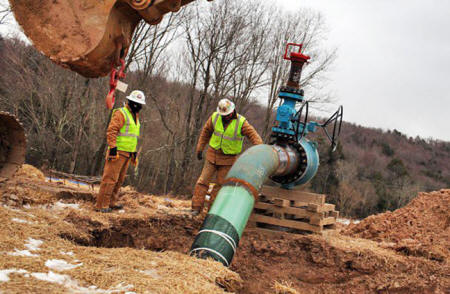|
by Andrew Martin
is crucial and is not optional - the laws of Thermodynamics cannot be repealed and Mother Nature has a way of settling such issues for those who choose to ignore them." David Hughes
The technique of fracturing rock formations entails oil and gas companies drilling a vertical shaft, often penetrating the earth for some two or three kilometers. Then, a horizontal well bore is drilled in an area believed to contain trapped natural gas or oil.
Under high pressure a cocktail of chemicals, water, and sand are pumped into the well.
This pressure creates fissures in the shale formation, from which oil and gas can escape.
It is only more recently that studies have been undertaken which highlight the consequences.
A recent study by a Cornell University-led research team, published in the National Academy of Sciences, underscored the risks of these operations.
The report into 41,000 conventional and
unconventional oil and gas wells in Pennsylvania revealed that many
of the oil and gas wells tapping the Marcellus Shale region of
Pennsylvania are leaking methane gas, either into the air or into
underground sources of drinking water. (1)
Fracking was banned in New York last week due to water pollution and climate concerns.
While the amount of water used for fracking varies widely from well to well, it seems strange to risk contamination of underground aquifers and ecosystems by polluting the most crucial resource on the planet. (1a)
In conjunction with the Post Carbon Institute, he outlines the fundamental problem with unconventional resource plays such as fracking:
Unlike traditional (conventional oil) fields which can take decades before they enter decline, fracking has high depletion rates. Estimates and predictions on the rate of depletion from unconventional oil and gas plays vary.
However, it is generally agreed that decline rates of individual wells are very steep, especially early in the life of the well (as much as 75% in the first year for the average Eagle Ford), though the decline rates become lower over time and eventually stabilize at around 6 to 7% per year in the Bakken. (3)
This means that once a well is fracked, most of the resource has been utilized, hence, the continual need to expand and move to new locations.
To put this into context, one of the largest oil fields in Saudi Arabia and the world, "Ghawar," produced up to 5 million barrels of oil per day in 2009. (4) It takes U.S. fracking operations thousands of wells and fields to match this one well's production output. Some of the U.S. fields are retrieving as little as 100 barrels of oil per day from a well, hence why they need to exploit more and more territory.
While significant amounts of (natural gas) are extracted through fracking, the more highly valued and prized product is shale oil, also known as tight oil.
This is a dramatic increase from the 1980's when the world was using around 58 million barrels per day. (5) Back in 1980 there were just over 400 million vehicles on the world's roads, today there are over 1 billion, most of which run on some form of crude oil.
Similarly, in those days China and India weren't major consumers of oil. Today China uses around 10.68 million barrels per day compared to the 19 million of the U.S.
The People's Republic of China now has the
second largest fleet in the world behind the U.S., with slightly more
than 78 million vehicles, overtaking Japan in 2010. (6)
Thus fracking has spread out of the U.S., where it originated, to many corners of the globe.
Off the back of the Josh Fox documentary "Gasland," "Frackman" is taking to the streets in Australia to raise awareness and try to put an end to the environmental destruction being perpetrated.
Check out
his efforts to help put an end to Coal Seam Gas exploration down
under…
|


